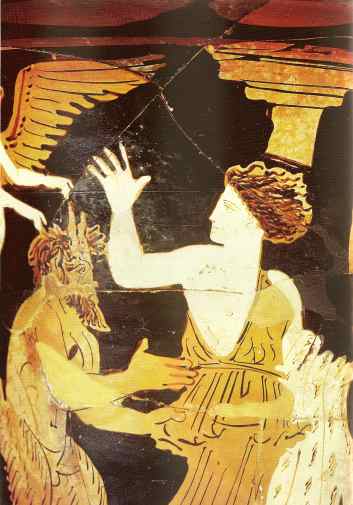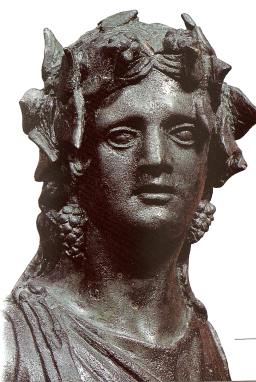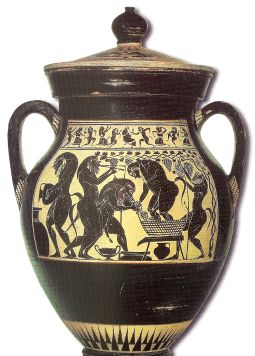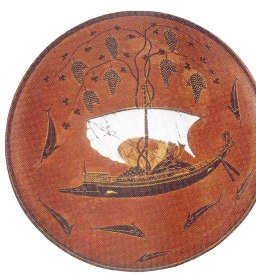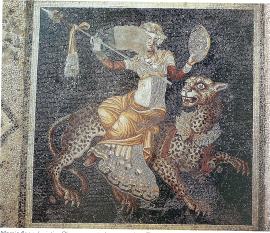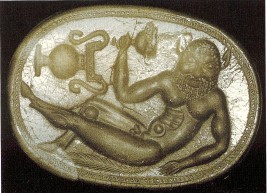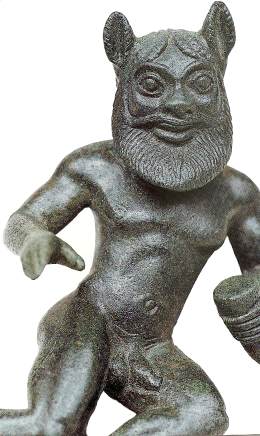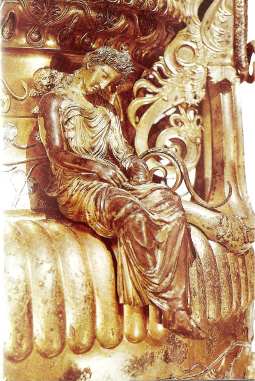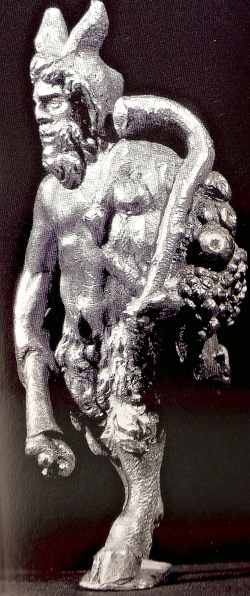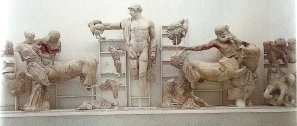Dionysus, "Drink Wine and Be Merry"
Originally a fertility god, he was identified with the patron god of winemaking and was later transformed into a mysterious god whose passions-including his death and resurrection-, symbolize the natural cycle of life and rebirth.
The god and the island of Naxos The god's birth
There are many versions of Dionysus's birth, as well as many locations in Greece which claim to be his birthplace. According to the most prevalent myth, the god was born in Thebes and his mother was Semele, daughter of Cadmus and Harmonia. Almighty god Zeus fell in love with Semele and lay with her in the palace of her father. But Zeus's jealous wife Hera, decided to take revenge on her husband's infidelity: Disguised as her nurse, she appeared before Semele and persuaded her to try to convince her divine lover to appear before her in his full Olympian glory, so as to prove his love. Zeus, after failing to dissuade her from her wish, finally had no option but to assume his divine form, all armed with his powerful lightnings and thunderbolts. As a result, poor Semele was burned and killed on the spot. To save the child she was carrying, Zeus took it from her womb and sewed it inside his thigh, where it remained until reaching term. Thus, Dionysus (meaning son of Zeus, from the greek word for Zeus, Dias)was born dithyrambos, or from two "doors" - his mother's womb and his father's thigh. According to a different version, the little infant was saved from the flames by Gaia, who wrapped him in the ivy that covered the walls of Cadmus's palace. Dionysus thus acquired the epithet pyrigenis, or born out of fire.
[top] The art of winemaking
The ancient Greeks attributed to Dionysus the introduction of vine cultivation and winemaking. What is noted, however, is that there are many places in Greece which claim the honor of being the first to produce wines. According to one of these mythical versions, king Icarius of Attica showed exceptional hospitality to the god, when he visited his palace. To reciprocate his eagerness to show respect for him, Dionysus rewarded the Athenian king by teaching him the art of vine cultivation and wine making. He cautioned him, however, to hide the flasks of wine that he would produce, because doing otherwise would lead to disaster. The king chose to ignore the god's advice, offering some wine to a group of passing shepherds, who got drunk, beat him to death and then tossed his body in a well. With help from her dog, Icarius's daughter Erigone eventually found his father's body. [top] The god and the island of Naxos
Following his birth, there are many versions as to where and by whom little Dionysus was raised. According to the most prevalent myth, the god was raised on the island of Naxos in Cyclades, by the nymphs Philia, Cleiade and Coronis. To account for its strong association with Dionysian cult, the island of Naxos uses to be called Dionysiada as well. To this day, the myths of the god remain alive in the island's folk traditions and culture. In order to show his gratitude for being so benevolent to him, the god blessed all the sland's inhabitants with happiness and abundance. Indeed, the island was so fertile that the ancient writers claimed that its rivers flowed with sweet, fragrant wine. On Naxos, the god married king Mino's daughter Ariadne, whom Theseus abandoned on the island. They had three children:Staphylus, Oenopion and Euadne. A notable adventure that the god had while he was in Naxos, is his abduction by Etruscan pirates: On a trip to Naxos, the pirates grabbed the merry god of wine and chained him to their ship. The chains, however, kept falling off his diveine body. Sweet wine also trickled from the ship into the sea and a vine entwined with sacred ivy grew around the ship's mast. To make the matters even worse for the abducters, the god changed into a lion and then into a bear. The crew of the ship were so frightened, that they jumped overboard into the sea, turning into dolphins.
[top] The god's Cult
The Dionysian rituals had elements of ecstacy and mysticism. Through an intoxication of the senses, worshippers would cleanse their souls and purify their lives. The bacchants, as Dionysus's followers were called, would dance around beating drums and playing flutes, shouting and making animal cries and carrying phalluses (imitations of male genital organs), which in ancient Greece were symbols of fertility. Since the god was closely linked and identified with the natural, seasonal cycle of withering and regeneration of vegetation, farmers were the first to worship Dionysus. The rich class of ancient Greece, watching this god assuming the identity of protector of the poor, saw him as a threat and originally banned his cult of taking place in the cities. But with the passage of time and the spread of vine cultivation, the god's cult also spread. As a matter of fact, many clever tyrants who sought to win the peoples' support, allowed the god's worshippers to practice their religious rituals freely. The most important Dionysian celebrations were the following:
[top] The god's companionsAccording to ancient greek mythology, Dionysus had a diverse crowd of companions and followers who were mythical entities, personifying different attributes of the Dionysian cult.[top] Satyrs and Seileni
The satyrs were half human, half animal and were considered to be minor demons of forests and mountains. According to the most prevalent version of their descent, they were said to be children of Hermes and Iptheme or of the Naiads and Seilenus. They looked like goats and had horns, long tails and hooved feet. They were cheerful and playful creatures who made advances to the nymphs and the maenads. Owing to their lustful behavior, even today, the term "satyr" is used to describe men, usually old, who exhibit such behavior. The satyrs were often linked, and even confused sometimes, with the seileni, who were demons of flowing waters and the vegetation of the land.
Like the satyrs, they were men with some animal features. But instead of resembling goats like the satyrs, the seileni has some physical traits of horses, like the half-horse, half-man creatures known as centaurs. The best known of the Seileni was Seilenus, Dionysus's tutor who was born from the blood that,according to the creation myth,dripped from Uranus's wound when his genitals were cut off. In art, Seilenus is often depicted as a bald old man with a thick nose, large ears and hog's ears. Like all satyrs and seileni, he was very fond of drinking wine and when under the influence, he possessed the gift of prophecy. [top] Maenads
Also known as Bacchae, Lynaes or Thyes, the maenads were female disciples of Dionysus. They were originally lesser deities whom the ancient Greeks identified with the nymphs who raised the god of wine and symbolized the divine natural powers of fertility and reproduction. Homer described the maenads as women who danced in delirious ecstasy, in the various processions taking place in the celebratory rituals. [top] Pan
God of forests and mountains and patron of herds, Pan was the son of god Hermes and the nymph Dryope. As the legend goes, when Pan was born, his mother was struck with awe when she realized that her newborn son had goat's feet and horns. Frightened, she abandoned the infant, but his father Hermes took the baby, wrapped it in a rabbit's skin and carried it to Mount Olympus. The Olympians were captivated by Herme's son strange looks, especially Dionysus, who named him Pan (or all), because everyone liked him. Carefree, cheerful and playful, Pan became a disciple of Dionysus. He roamed through woods and over mountains, chased nymphs, played his beloved pipes and generally led a care free life. He frequently amused himself by creeping up on flocks of sheep and emitting loud cries and thus startling the animals, causing them to panic - a word inspired by the god's name. [top] Centaurs
Centaurs were mythical creatures who were, from the waist up, human, while from the waist down they had the form of a horse. According to myth, the first Centaur was born from the union of Ixion and Nephele, a cloud, whom Zeus had changed into the form of Hera. According to a different version, however, Nephele gave birth to many centaurs who in turn united with the mares of Mount Pelion, thus giving birth to the half-human, half-horse creatures. The Centaurs were associated with Dionysus through their great reputation for their fondness of red wine and their tendency to create fights whenever they got drunk. Their most notable involvement in a fight, is the one that took place at the wedding of the king of Lapiths, Peirithous, with Hippodameia. Due to wine consumption, one of the centaurs who were invited at the celebration by the name of Eurytus, showed inappropriate behavior, stirring up a fight between the Lapiths and the centaurs. As a result, the centaurs were defeated and driven away from Thessaly, which was their original location. The legendary hero of Athens, Theseus,helped his friend Peirithous to win the centaurs. This was not the only case that the centaurs caused trouble. When mighty Hercules was returning to Mycenae after performing his fourth labor (the capture of the Erymanthian Boar), he had to fight with centaurs, when they got mad after smelling the wine that Hercules's centaur friend Pholus had given him as a gift. Lust was another one of the centaurs's characteristics. Greek mythology contains a lot of references about their amorous attacks on nymphs and mortal women. The most well known, is the incident involving centaur Nessus,Hercules and the hero's wife Deianeira. The centaur tried to rape Hercules's wife, but the hero managed to kill him with his poisonous arrows. The most famous centaur was Cheiron. He was the son of Cronus, who disguised himself as a horse to lay with the oceanid Philyra and lived on Mount Pelion. Cheiron was considered to be very wise and was known to have raised and educated great heroes like Hercules and Jason. As the myth goes, god Apollo entrusted him his son Asclepius, god of medicine, for his education, since the centaur was very knowledgeable in medicine. Cheiron had a tragic end, when he was accidentally hit by one of Hercules's poisonous arrows. Unable to withstand the pain inflicted by the wound, he gave up his immortality, transferring it to Prometheus.
Return from Dionysus to Greek Pantheon
|
|||||||||||
Resource MaterialClassroom MaterialMovies,DVDs, Games and BooksAbout the SiteYour Stories |
|||||||||||
|
|
|||||||||||
